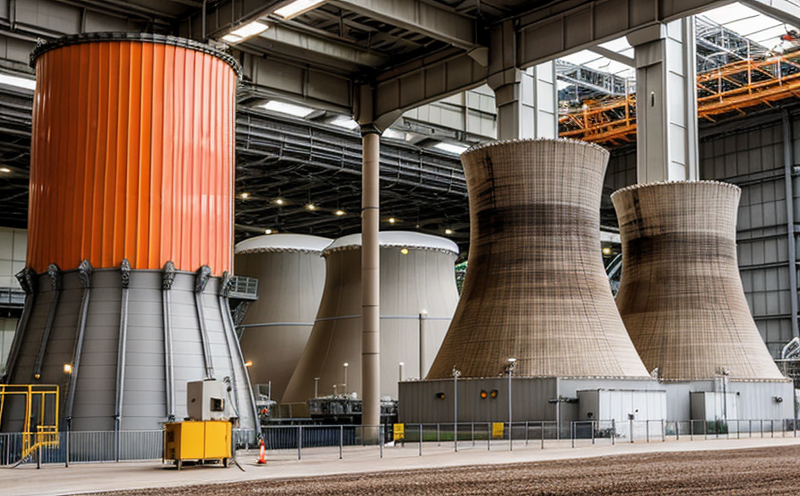ISO 14627 High Temperature Testing of Ceramic Reactor Components
The ISO 14627 standard provides a comprehensive framework for evaluating the mechanical and physical properties of ceramic materials under extreme conditions relevant to nuclear reactor environments. This service is specifically designed to assess the performance of ceramic components used in high-temperature applications, ensuring their reliability and safety within nuclear power plants.
Our laboratory adheres strictly to ISO 14627, which outlines rigorous testing protocols for various ceramic materials including zirconium dioxide (ZrO₂), silicon carbide (SiC), aluminum nitride (AlN), and other advanced ceramics. The tests are critical in verifying the mechanical strength, thermal stability, and resistance to creep at elevated temperatures, all of which are essential for ensuring the longevity and safety of nuclear reactor components.
The testing process begins with careful specimen preparation, where each component is subjected to precise dimensions and surface finish requirements as per ISO 14627. Specimens undergo initial visual inspection followed by dimensional analysis using optical profilometers or coordinate measuring machines (CMMs). Once prepared, the specimens are subjected to a series of tests that include high-temperature endurance testing in controlled atmospheres, creep tests at elevated temperatures, and thermal shock resistance evaluations.
High-temperature endurance testing is conducted in an inert atmosphere furnace capable of reaching temperatures up to 1800°C. The specimens are held at these elevated temperatures for extended periods while continuously loaded to simulate the stresses they would encounter during reactor operation. This helps in identifying any potential failure mechanisms such as creep or oxidation.
Creep tests are conducted under constant load conditions, typically over a period of several hours to days, depending on the material and temperature. These tests provide insights into the deformation behavior of ceramics at elevated temperatures, which is crucial for understanding their long-term performance in nuclear reactors.
The thermal shock resistance evaluation involves rapid cycling between high and low temperatures while applying a load. This assesses the material's ability to withstand sudden changes in temperature without fracturing or degrading its mechanical properties.
Once all tests are completed, detailed reports are generated, providing comprehensive data on the mechanical behavior of each component under extreme conditions. These reports serve as critical documentation for quality control and compliance purposes within nuclear power plant operations.
The ISO 14627 protocol ensures that only materials meeting stringent criteria can be approved for use in nuclear reactors. By adhering to this standard, our laboratory contributes significantly to enhancing the safety and reliability of nuclear power generation systems worldwide.
Industry Applications
- Zirconium dioxide (ZrO₂) used in fuel cladding due to its excellent thermal conductivity and high-temperature stability.
- Silicon carbide (SiC) employed for wear-resistant coatings on reactor internals due to its hardness and chemical inertness.
- Aluminum nitride (AlN) utilized as an insulating material within the reactor core because of its low dielectric constant and thermal conductivity.
Why Choose This Test
The ISO 14627 high-temperature testing is essential for ensuring the safety and reliability of ceramic materials in nuclear reactors. By subjecting these components to extreme conditions, we can identify potential weaknesses or failure modes before they become critical issues during operation.
Quality managers and compliance officers rely on this service to verify that all materials comply with international standards such as ISO 14627. This ensures not only regulatory compliance but also enhances the reputation of nuclear power plants by demonstrating a commitment to excellence in material selection and quality assurance.
R&D engineers can benefit from this testing by gaining deeper insights into how different ceramic materials perform under various stress conditions. This information is invaluable for optimizing design parameters, improving manufacturing processes, and developing new materials tailored specifically for high-temperature applications.
For procurement teams, ISO 14627 compliance offers peace of mind knowing that the components they source meet stringent quality standards. This reduces risks associated with material failures and ensures a smoother supply chain process.
International Acceptance and Recognition
The ISO 14627 standard is widely recognized by international organizations, regulatory bodies, and industry leaders as the gold standard for testing ceramic materials in nuclear applications. Its acceptance across borders ensures that results obtained are universally valid and comparable.
This global recognition also facilitates smoother collaboration between different countries involved in nuclear power generation projects, promoting a harmonized approach to material quality assurance. Compliance with ISO 14627 is often a prerequisite for international certifications and accreditations, further enhancing the credibility of the laboratory’s services.





